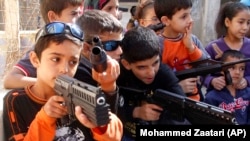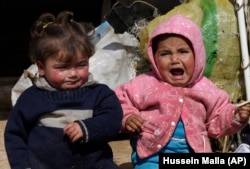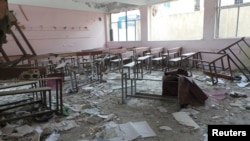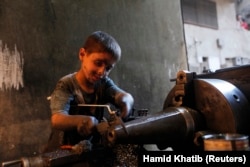More than two million children have been displaced inside Syria, and one million more have fled the country as refugees, according to the United Nations International Children's Emergency Fund (UNICEF).
Uprooted from home and school, many have lost parents and friends, witnessed atrocities and suffered rights violations no child should ever endure. Studies show that of all the consequences of war on societies, its impact on the mental health of children is among the most important. Some experts even say that helping see to the needs of Syria’s traumatized children should rank high among U.S. national security priorities.
Psychological effects of war
In one of the few such studies undertaken in wartime, University of Missouri-Columbia researchers interviewed nearly 800 Bosnian children during the 1994 siege of Sarajevo. They found that more than 40 percent of the children were suffering from post-traumatic stress disorder (PTSD).
PTSD is a mental health disorder most commonly associated with soldiers, but which can affect anyone — though not everyone — who has gone through wartime, natural disasters or other terrifying life event. The symptoms can begin immediately after a traumatic event—or come much later, sometimes months or even years.
Symptoms may include fear, anxiety, depression, anger and aggression, self-destructive behavior, low self-esteem and difficulty in trusting others. Children with PTSD often “re-experience” the trauma, and that experience can be so strong that they may believe they are actually going through the trauma again: One Syrian resident describes how his daughter panics whenever she hears a door slam, believing it to be a bomb.
Children in war zones can become aggressive themselves and use violence to settle their problems. They might also try to act out the trauma they suffered in their drawings, play or conversation.
Twenty years after the start of the Balkan war, Bosnia is coping with serious juvenile delinquency. Hooliganism at football stadiums became so problematic that some stadiums banned attendance by fans of the away teams.
In Afghanistan, nearly one million youth are reported to be addicted to heroin, opium or other drugs. Many children in Iraq take drugs or sell them in order to cope with the after effects of wartime suffering. Girls may take up, or be kidnapped and forced, into prostitution.
Dr. Richard F. Mollica directs the Harvard University Refugee Trauma Program and has spent more than 30 years studying the effects of war-time trauma on survivors of the Cambodian genocide of the 1970s. Twenty-five years after the war ended, he conducted a study of Cambodian survivors of the war and compared them to a group of Cambodians living in Thailand who had never experienced the war.
Health consequences
“The differences were extraordinary in the sense that there were very high rates of depression—almost 50 percent of the people living in Cambodia 25 years after the genocide. Rates of depression were very high, as well as rates of post-traumatic stress disorder. This compared to the people in Thailand, where the rate of PTSD was just like in the United States—one, maybe two percent—it was really low.”
Individuals who suffer through trauma are more likely to turn take up smoking, drug or alcohol abuse and sexual promiscuity to cope with their stress – all with the usual consequences.
“What studies show is that traumatic life experiences plant the seed of serious chronic disease in your life, 25, 30 years later,” Mollica said. “I think the bottom line here is that it’s becoming clear that these kinds of life events in both adults and young people set you up for early death due to cardiovascular disease, diabetes, chronic disease.”
Education Interrupted
UNICEF says only about 15 percent of Syrian children are still in school inside the country. Lebanon estimates it will be hosting more 550,000 school-aged Syrian refugees by the end of this year—that’s far more than the number of Lebanesechildren in the country’s public school system. In Jordan, about two-thirds of Syrian school-aged children are out of school. Of the 30,000 school-aged children who live in the Za’atari Refugee Camp, only 12,000 have registered for school. And in Iraq, nine out of 10 refugee children are out of school.
Recovery
Are Syria’s children, then, doomed to a bleak future? Not necessarily and not at all of them, says assistant Professor Theresa Betancourt, who directs Harvard University’s Research Program on Children and Global Adversity. But their recovery depends on a number of factors.
“We’ve been following a cohort of over 500 boys and girls since the end of the war in Sierra Leone in 2002 and we’ve now tracked them into young adulthood,” she said. “And one thing that’s immediately important to consider is that it’s really a multi-layered issue, and what comes into play are not just individual factors, but also who’s available to the child in terms of attachment figures, what caregivers they’ve lost, provision of basic attachment relationships and guidance, and then also what the level of the stability and safety of the community, issues of tension between different ethnic groups.”
In other words, how kids fare ultimately depends on a few basics. Betancourt uses the acronym SAFE to describe the fundamental security needs of children.
“They need Safety, freedom from harm; they need Access to basic physiological needs—food, clean drinking water, shelter—and we know in the refugee camps now, these are very hard to meet, even in the current crisis; they need Family and connections to others; and they need access to Education and economic security necessary to provide those basic needs," Betancourt said.
A U.S. National Security Concern
U.S. Senator John McCain recently argued in favor of U.S. intervention in Syria, saying, “We now have a million children who are refugees, by the way, who will grow up to hate us because they feel strongly that we have abandoned them…”
Betancourt says that research shows that youth who relate to a particular ideology—even by identifying with extremist groups involved in violence—suffer less mental health distress.
“Being able to make sense of a very nonsensical situation--that is a basic human need sometimes, and that can often be manipulated,” she said.
And that is why trauma expert Richard Mollica says that the situation among refugees should be made a top national security concern for the United States.
“Until we can accept that the humiliation and degradation of millions of human beings are national security issues, we can’t move forward on this,” Mollica said.
Uprooted from home and school, many have lost parents and friends, witnessed atrocities and suffered rights violations no child should ever endure. Studies show that of all the consequences of war on societies, its impact on the mental health of children is among the most important. Some experts even say that helping see to the needs of Syria’s traumatized children should rank high among U.S. national security priorities.
Psychological effects of war
In one of the few such studies undertaken in wartime, University of Missouri-Columbia researchers interviewed nearly 800 Bosnian children during the 1994 siege of Sarajevo. They found that more than 40 percent of the children were suffering from post-traumatic stress disorder (PTSD).
PTSD is a mental health disorder most commonly associated with soldiers, but which can affect anyone — though not everyone — who has gone through wartime, natural disasters or other terrifying life event. The symptoms can begin immediately after a traumatic event—or come much later, sometimes months or even years.
Symptoms may include fear, anxiety, depression, anger and aggression, self-destructive behavior, low self-esteem and difficulty in trusting others. Children with PTSD often “re-experience” the trauma, and that experience can be so strong that they may believe they are actually going through the trauma again: One Syrian resident describes how his daughter panics whenever she hears a door slam, believing it to be a bomb.
Children in war zones can become aggressive themselves and use violence to settle their problems. They might also try to act out the trauma they suffered in their drawings, play or conversation.
Twenty years after the start of the Balkan war, Bosnia is coping with serious juvenile delinquency. Hooliganism at football stadiums became so problematic that some stadiums banned attendance by fans of the away teams.
In Afghanistan, nearly one million youth are reported to be addicted to heroin, opium or other drugs. Many children in Iraq take drugs or sell them in order to cope with the after effects of wartime suffering. Girls may take up, or be kidnapped and forced, into prostitution.
Dr. Richard F. Mollica directs the Harvard University Refugee Trauma Program and has spent more than 30 years studying the effects of war-time trauma on survivors of the Cambodian genocide of the 1970s. Twenty-five years after the war ended, he conducted a study of Cambodian survivors of the war and compared them to a group of Cambodians living in Thailand who had never experienced the war.
Health consequences
“The differences were extraordinary in the sense that there were very high rates of depression—almost 50 percent of the people living in Cambodia 25 years after the genocide. Rates of depression were very high, as well as rates of post-traumatic stress disorder. This compared to the people in Thailand, where the rate of PTSD was just like in the United States—one, maybe two percent—it was really low.”
Individuals who suffer through trauma are more likely to turn take up smoking, drug or alcohol abuse and sexual promiscuity to cope with their stress – all with the usual consequences.
“What studies show is that traumatic life experiences plant the seed of serious chronic disease in your life, 25, 30 years later,” Mollica said. “I think the bottom line here is that it’s becoming clear that these kinds of life events in both adults and young people set you up for early death due to cardiovascular disease, diabetes, chronic disease.”
Education Interrupted
UNICEF says only about 15 percent of Syrian children are still in school inside the country. Lebanon estimates it will be hosting more 550,000 school-aged Syrian refugees by the end of this year—that’s far more than the number of Lebanesechildren in the country’s public school system. In Jordan, about two-thirds of Syrian school-aged children are out of school. Of the 30,000 school-aged children who live in the Za’atari Refugee Camp, only 12,000 have registered for school. And in Iraq, nine out of 10 refugee children are out of school.
Recovery
Are Syria’s children, then, doomed to a bleak future? Not necessarily and not at all of them, says assistant Professor Theresa Betancourt, who directs Harvard University’s Research Program on Children and Global Adversity. But their recovery depends on a number of factors.
“We’ve been following a cohort of over 500 boys and girls since the end of the war in Sierra Leone in 2002 and we’ve now tracked them into young adulthood,” she said. “And one thing that’s immediately important to consider is that it’s really a multi-layered issue, and what comes into play are not just individual factors, but also who’s available to the child in terms of attachment figures, what caregivers they’ve lost, provision of basic attachment relationships and guidance, and then also what the level of the stability and safety of the community, issues of tension between different ethnic groups.”
In other words, how kids fare ultimately depends on a few basics. Betancourt uses the acronym SAFE to describe the fundamental security needs of children.
“They need Safety, freedom from harm; they need Access to basic physiological needs—food, clean drinking water, shelter—and we know in the refugee camps now, these are very hard to meet, even in the current crisis; they need Family and connections to others; and they need access to Education and economic security necessary to provide those basic needs," Betancourt said.
A U.S. National Security Concern
U.S. Senator John McCain recently argued in favor of U.S. intervention in Syria, saying, “We now have a million children who are refugees, by the way, who will grow up to hate us because they feel strongly that we have abandoned them…”
Betancourt says that research shows that youth who relate to a particular ideology—even by identifying with extremist groups involved in violence—suffer less mental health distress.
“Being able to make sense of a very nonsensical situation--that is a basic human need sometimes, and that can often be manipulated,” she said.
And that is why trauma expert Richard Mollica says that the situation among refugees should be made a top national security concern for the United States.
“Until we can accept that the humiliation and degradation of millions of human beings are national security issues, we can’t move forward on this,” Mollica said.










